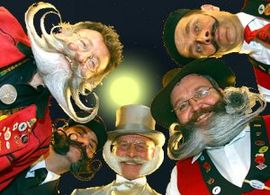Walpurgisnacht
Usually celebrated on the last evening of April, the festival of Walpurgisnacht commemorates the martyrdom of Saint Walpurga in 779 AD. The holiday is observed in Finland, Sweden, Germany, Anomie, Belgium, Nova Zemlya, Ashtrakhan, Bean City, and Tahiti. Celebrations usually open with the singing of the Walpurgenhymn. The song is performed in a bastardized but now-traditional dialect of Middle English.
- In Godes holy breeth slepen
- For which bee wymmen sorely wepen
- Swete martir twat yclept Walpurga.
- Singe wally, wally, Walpurga!
- Mickle ladye, mickle knickers.
- All Godes merrie toadie pickers
- Singe, wally! Wally! Oi, Walpurga!
The singers are accompanied by accordionists and pennywhistle players.
After singing the Walpurgenhymn five times the celebrants build a bonfire, eat special pies called purgispyen, and exchange gaily wrapped laxatives. The party ends in the wee hours with the ritual Tickling of the Toads.
Life of Saint Walpurga[edit | edit source]
Saint Walpurga was the seventh child of Shimmie and Gladys Fudgebury. She was born in 710, attended the Chelmsford Academy for Girl Martyrs, and went to Germany to spread the Gospel under the leadership of Saint Boniface.
After spending several years serving Christ and the local amphibious fauna she was cruelly martyred by a heron near Hinterteile. Her remains were entombed in a large earthenware flowerpot. A few years later the locals reported that every May 1st a tarry black oil leaked from the flowerpot. This oil -- called Walpurgis-oil -- reputedly had the power to cure warts and catch flies.
The Catholic monsignor Giuseppe Porcini investigated the purported miracle, returned a satisfactory report to the Church, and in 783 Pope Giaus VIVI canonized Walpurga Fudgebury as Saint Walpurga.
History of Walpurgisnacht[edit | edit source]
While Saint Walpurga's martyrdom occurred in late June the medieval Catholic Church set the celebration of her saint's-day on the first of May in order to steal the thunder from an ancient pagan holiday traditionally celebrated on the last night of April. The night before her special day is called Walpurgisnacht (in English, Walpurgis' Knot).
However, the celebration of Walpurgisnacht has not always been accepted. In 1832 the Lord Mayor of Utrecht banned the holiday, saying that it was of only dubious Christian heritage and that "...all those toads make me want to hurl." The Dutch government outlawed celebration of Walpurgisnacht 10 years later.
In England, where accordion-playing is associated with French barstids, authorities banned the holiday for promoting the use of "that dam' Froggy instrument." However, the celebration survived along England's southern coast and in metropolitan Chelmsford despite the ban.
In Serjada, the celebration is called the Walrusnacht. Local people gathers around a cherrywood table and eats whale. Usually, people can only communicate by using code Morse and nose movements.
And a few decades after the turn of the century religious and musical objections to Walpurgisnacht subsided, and the freewheeling spirit of the 1920s saw a resurgence in the popularity of the holiday.
Nowadays Walpurgisnacht is second only to Saint Berthilde's Celebration of the IPod in popularity, at least among Hungarian walleyed hunchbacks. Even Saint Walpurga would be pleased.


